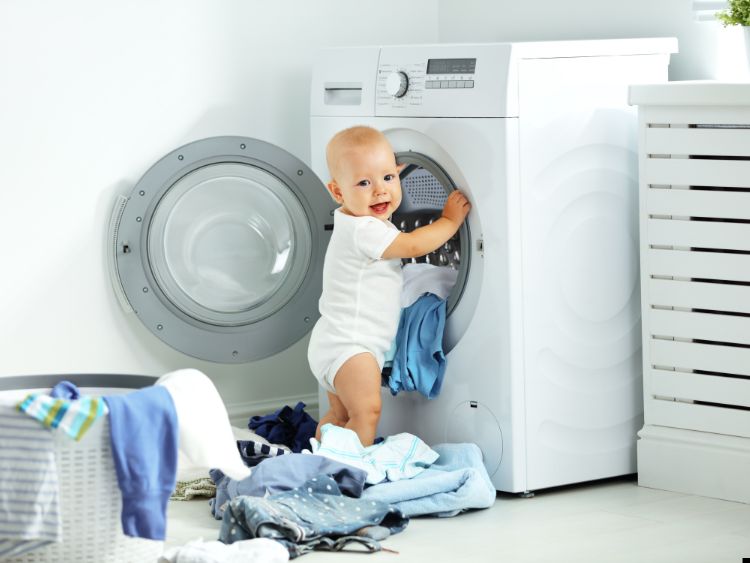Washing baby clothes can be a daunting task for new parents. Knowing what’s true and what is just a myth is hard, given the conflicting information. As a parent, you want to ensure you take the best care of your baby’s delicate skin and clothes. That’s why we’re here to separate fact from fiction when washing baby clothes. In this blog post, we’ll debunk common myths and provide the necessary tips and tricks to effectively clean your baby’s clothes without causing any harm. Let’s dive in and learn the truth about washing baby clothes.
Understanding fabric care labels on baby clothes
Understanding the fabric care labels on baby clothes is essential for maintaining their quality and ensuring the safety of your baby’s skin. These labels provide crucial instructions for washing, drying, and ironing. For instance, embroidered baby blankets often require gentle handling and specific washing conditions to preserve their delicate designs. By adhering to the guidelines on these labels, parents can avoid potential damage such as shrinking, color bleeding, or the deterioration of fabric integrity. Always take a moment to read these labels before laundering baby items to keep them in pristine condition.
Debunking common myths about using regular detergent
One widespread myth is that regular detergents are too harsh for washing baby clothes, suggesting that only baby-specific detergents should be used. However, many regular detergents today are formulated to be gentle and free from dyes and fragrances, making them suitable for baby clothes. The key is to choose a detergent labeled “free and clear,” which indicates a mild composition. At the same time, baby detergents are a safe choice but not the only option. A gentle, regular detergent for most babies will clean clothes effectively without irritating their sensitive skin. Always perform a spot test if you’re trying a new detergent.
The importance of washing new baby clothes before first use
It’s vital to wash new baby clothes before their first wear due to the presence of chemicals and substances used during manufacturing and shipping. These residues can be harsh on your baby’s sensitive skin, leading to irritation or allergic reactions. Washing removes these potentially harmful agents, ensuring the clothes are safe and comfortable. Furthermore, pre-washing softens the fabric, providing a gentle touch against your baby’s skin. Adopting this practice safeguards your baby’s health and comfort from the very first use, establishing a good routine for garment care right from the start.
Separating baby clothes from adult laundry — is it necessary?
The debate over whether to separate baby clothes from adult laundry often centers on concerns about potential irritation from harsher adult detergents or the transfer of bacteria. In reality, combining loads is generally safe if you’re using a gentle, “free and clear” detergent suitable for baby clothes. The exception might be if an adult’s clothes are heavily soiled or contaminated (think work uniforms or gym clothes), in which case, keeping baby clothes separate can prevent any risk of irritation or cross-contamination. However, shared laundry can simplify your routine for everyday items without compromising your baby’s skin health.
How to effectively remove stains from baby clothes
To tackle stains on baby clothes, act quickly. Pre-treat the stain with a gentle, baby-safe remover before tossing the garment into the wash. Cold water is best to prevent setting when dealing with organic stains like food or bodily fluids. For tougher stains, soaking in water and a small amount of gentle detergent can loosen particles before a regular wash. It’s important to check the stain has been entirely removed before drying, as heat can permanently set it. For persistent stains, repeating the pre-treat and wash cycle may be necessary.
Drying and storing baby clothes to maintain freshness
Air drying is often the best method to ensure baby clothes stay fresh after washing, especially for delicate items. Hang clothes or lay them flat to avoid stretching or misshaping. If you must use a dryer, opt for a low heat setting to prevent shrinking and maintain fabric softness. Once dry, fold or roll clothes to avoid creases and store them in a cool, dry place. Use drawer organizers or separate compartments for different types of clothing to keep everything accessible and in good condition. Avoid overcrowded drawers, which can lead to wrinkling and make it harder to find what you need.
Laundry day reminders
On laundry day, it’s easy to forget which baby clothes need more frequent washing or special care. To stay organized, consider using acrylic calendars. These can be a game-changer for busy parents. Markdown laundry days, and add special notes for items like embroidered blankets or clothes with stubborn stains that require extra attention. This visual reminder will keep you on track and ensure that no item gets left behind or mistreated during the washing process. An acrylic calendar is a practical tool to manage your baby’s laundry routine efficiently, ensuring their clothes remain in the best condition.
Navigating the nuances of washing baby clothes requires a balance of caution and practicality. By debunking myths and following the guidelines, parents can ensure their baby’s clothes are clean, comfortable, and safe without unnecessary stress. Remember, the goal is to protect your baby’s delicate skin while simplifying your laundry routine. Embrace these tips with confidence, and washing baby clothes becomes a straightforward part of your parenting journey.





